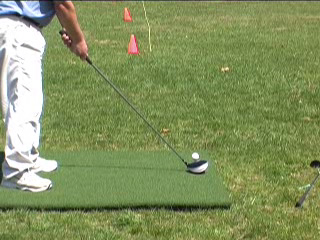The Golf Mat is made by a company called National Golf Products. The product itself is very simple in appearance. You'll immediately recognize it for what it: you know, a golf mat. It's a strip of artificial turf surrounded by a black border that includes a slot at top (the side farthest from the golfer at setup) and bottom where extra golf balls can sit; there's a tee near the top of the mat.
While hitting a teed ball off range mats doesn't pose a problem, hitting unteed balls off range mats can adversely affect your swing.

The main problem with range mats is that they don't allow you to take divots. When an iron impacts real grass, it digs in and scoops out a chunk of turf leaving the so-called divot. When this happens in relation to contact with the golf ball is all the difference with iron ball-striking. When hit properly, the iron contacts the ball before it impacts with the turf. If the iron hits the turf before the ball, the turf will interfere with the iron on ball contact resulting in the so-called "fat" shot (see picture). Besides the dreaded shank, the fat shot is the ugliest shot in golf. Laying sod is for landscaping your yard, not for hitting a golf ball.

Most golf mats use a rubber tee of a predetermined height forcing you to adjust to it. New Country Club Elite Real Feel Long Dense Fiber System accepts a real wooden tee allowing you to choose and vary your tee height for various clubs. Rubber tees can obstruct your club-head at the point of impact giving you a different feel than you get off of a real tee.
Look at The Golf Mat from the side and you'll notice that the hitting area is very slightly raised. The artificial turf is on top of a springloaded polymer-filament board. You can press on it with your hand or foot to see that it depresses, then springs back into place.

So when you use The Golf Mat on an iron shot, your club can - as it should on a properly struck iron shot - make contact with the ball first, then continue downward, next striking the surface of The Golf Mat. And because of that springboard construction, The Golf Mat gives, allowing the iron to reach the bottom of the swing.
While hitting a teed ball off range mats doesn't pose a problem, hitting unteed balls off range mats can adversely affect your swing.

The main problem with range mats is that they don't allow you to take divots. When an iron impacts real grass, it digs in and scoops out a chunk of turf leaving the so-called divot. When this happens in relation to contact with the golf ball is all the difference with iron ball-striking. When hit properly, the iron contacts the ball before it impacts with the turf. If the iron hits the turf before the ball, the turf will interfere with the iron on ball contact resulting in the so-called "fat" shot (see picture). Besides the dreaded shank, the fat shot is the ugliest shot in golf. Laying sod is for landscaping your yard, not for hitting a golf ball.

Most golf mats use a rubber tee of a predetermined height forcing you to adjust to it. New Country Club Elite Real Feel Long Dense Fiber System accepts a real wooden tee allowing you to choose and vary your tee height for various clubs. Rubber tees can obstruct your club-head at the point of impact giving you a different feel than you get off of a real tee.
Look at The Golf Mat from the side and you'll notice that the hitting area is very slightly raised. The artificial turf is on top of a springloaded polymer-filament board. You can press on it with your hand or foot to see that it depresses, then springs back into place.

So when you use The Golf Mat on an iron shot, your club can - as it should on a properly struck iron shot - make contact with the ball first, then continue downward, next striking the surface of The Golf Mat. And because of that springboard construction, The Golf Mat gives, allowing the iron to reach the bottom of the swing.